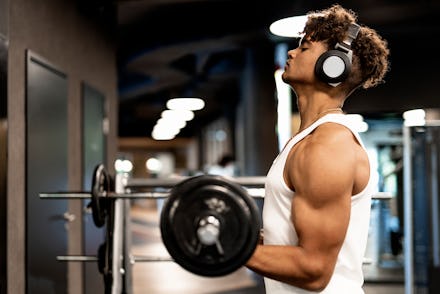Here's a good reason to ignore the mirror when you lift weights

Fitness enthusiasts know all too well how our pecs, lats, biceps, triceps, and the rest of the muscles we sculpt while lifting weights are intrinsically linked to the brain — that other, pretty important muscle inside our skulls. Several studies have shown their intermingling can yield visible results; in fact, there’s a widespread belief that looking at and concentrating on the muscle you’re trying to develop during a particular exercise alone can help increase muscle mass. But a new study, published today in the journal Frontiers in Sports and Active Living, counters that long-held, (kind of narcissistic) belief with evidence that looking at the object you’re lifting — instead of your own muscles — could be even more beneficial.
As far back as the late ՚70s, the former Governor of California and sometime-Terminator Arnold Schwarzenegger wrote about the benefits of a “positive mental attitude,” razor focus on form, and thinking about what individual muscles are doing while bodybuilding. To a guy with the literal title of “Mr. Universe,” checking himself out in a mirror was nothing to shy away from.
As a result of concentrating on specific muscles during lifting exercises, some studies show, “you recruit more fibers and consequently the muscle grows faster and more convincingly,” as reported by VICE last year. This phenomenon is called the “muscle-mind connection,” and belief in it gives gym rats “license to look in the mirror just a little too much."
However, the new study suggests cutting down on the self-appreciation in the form of staring at your muscles could ultimately produce better results. “The higher overall muscle activity with an internal ‘muscle focus’ is not specific to the muscles mentally isolated during lifting,” David Neumann, a professor at Griffith University in Australia and the study’s author, told the American Association for the Advancement of Science. “Rather, it seems to represent increased activity of non-target muscles, too.”
In simple language, it appears that gazing at the muscle you’re building during an exercise is actually an inefficient use of energy, as it triggers other, surrounding muscles to work as well. “To maximize muscular efficiency,” the study says, “an external focus of attention is more optimal than an internal focus of attention or no specific focus in most cases.”
Instead, Neumann recommends concentrating “on moving a load, to maximize athletes’ performance in training and competition.” In other words, tried-and-true exercises designed to work out individual muscles will be optimized if you just simply do the exercise, relying on its productivity promises. So while working out, you should look at the actual weight itself — a dumbbell or the heavy bar when doing bench presses, for example.
Neumann suggests this specific focus “as a potential complement to ‘dissociative’ focus strategies, like listening to music, for promoting exercise adherence in those who are less active.” He also believes virtual reality (VR) technology has a place in the gym. “We should also explore ways to maximize the beneficial effects of an external focus,” he said. “Using VR for instance, completing a deadlift could be translated into an imperative like virtually lifting a heavy bar to free a trapped virtual person.”
Neumann did write that greater research should be conducted to conclude which method, utilizing an internal or external focus, is best. In the meantime, try ignoring your own reflection at the gym — if at all possible — to see if your reflection at home eventually bears better results.